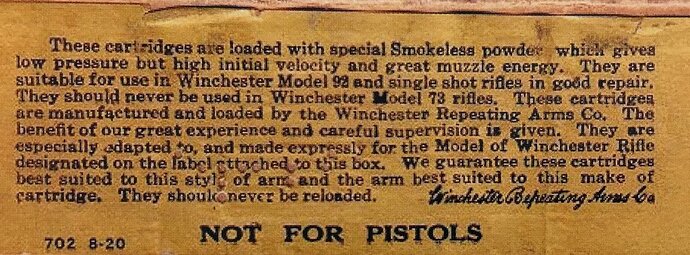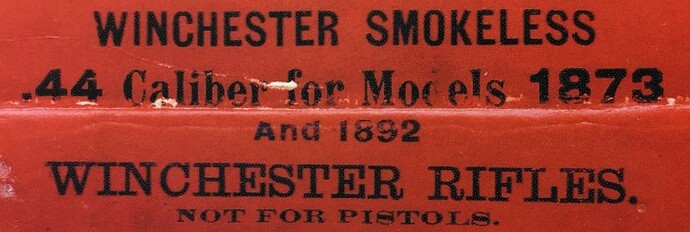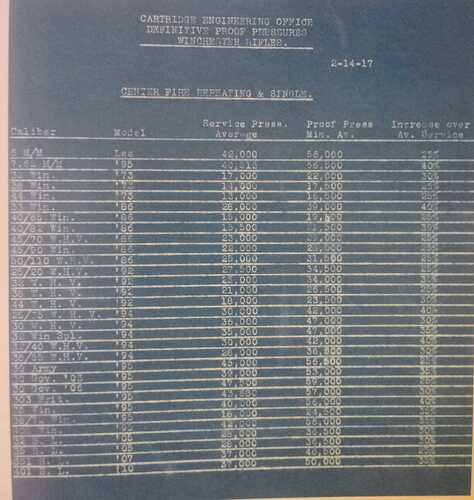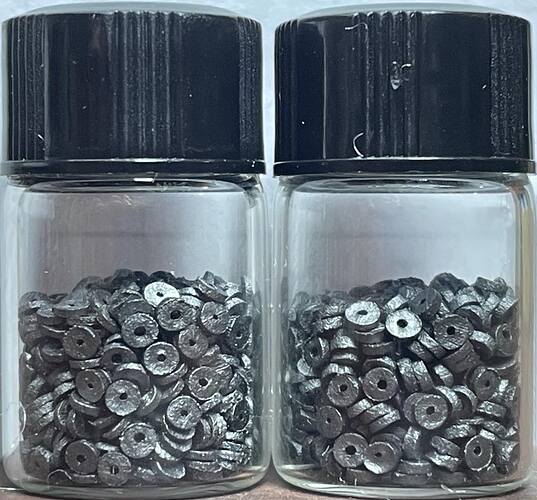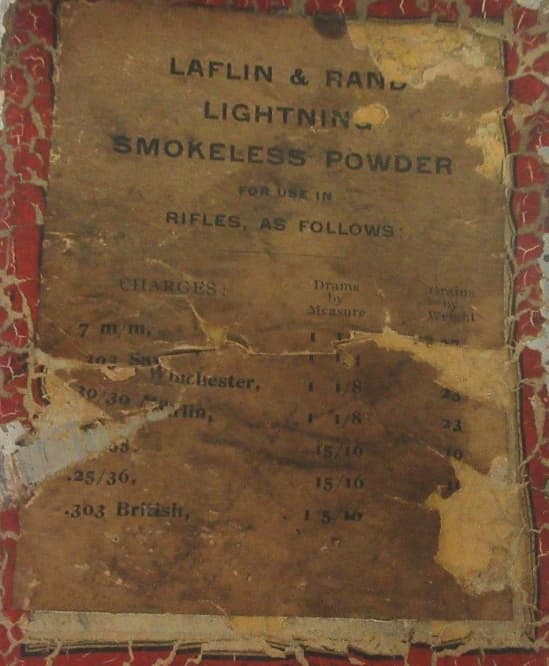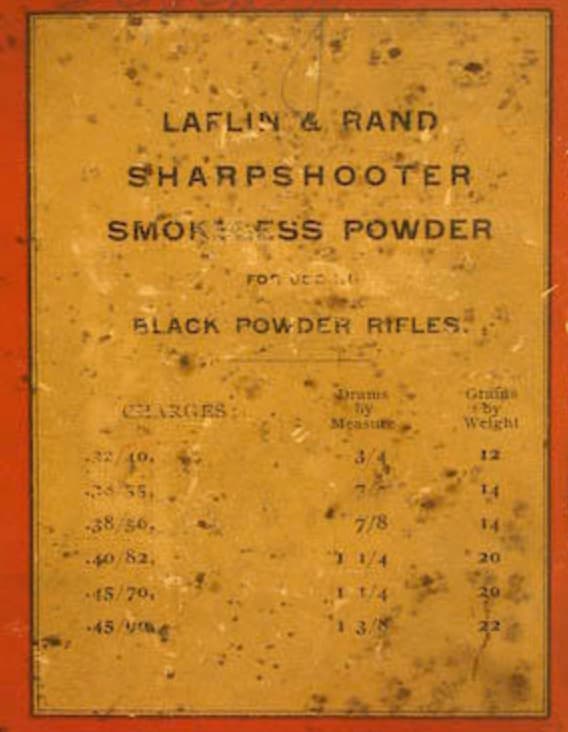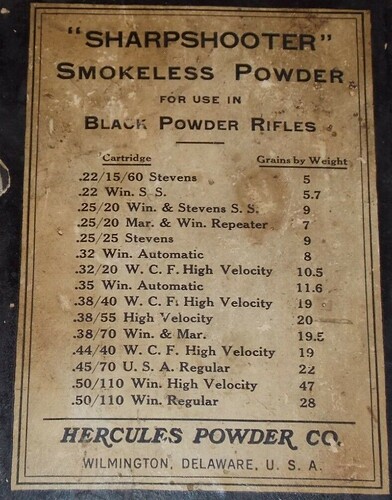Welcome @curtisshawk21 to Sixguns.
Where did you find that label?
On the side of a 44-40 Winchester High Velocity box. Label date is Aug 1920.
This one is a normal 44 WCF load between 1900 and 1903.
Even though one of the original rounds for the 1873 Model P “Peacemaker” was 44-40, they did have Rifle only 44-40. I had heard that before and you have some backup. I wonder how many cowboys couldn’t read and ran the rifle round in their sixgun?
1917 Winchester Ammunition Engineering data
Ammunition Service Pressures
Winchester 73’ 13,000cup
Winchester 92’ 18,000cup
Welcome to the Sixguns Fraternity @BryanAustin glad to have you. Great place to contribute and learn . Some very experienced members here.
That is a real piece of history. What other cool stuff do you have squirreled away?
Thanks guys. I don’t want others to get caught up in the ball of ignorance that I am in. I want to share every piece of data I can get my hands on, rather than keeping it hid and wasting. I have learned that the many rich that are deep into the collecting world rob us all from great data that is secretly tucked away in a safe…or hidden in a $500 dollar book.
I learn something new nearly every day, but sometimes a ton drops in my lap in just a few minutes. I never want credit for anything, because I didn’t come up with this stuff. I share what I know for all to enjoy.
The numbers for the 30WHV ( Winchester High Velocity) were impressive 36000 -47000 a 30% increase I wonder if people were shooting the 30 WHV rounds in .30WCF barrels which were the regular steel barrels and not the Nickel alloy barrels designed metallurogy specifically for the 30WHV
The nickel steel was introduced in 1895 and WHV was as I stated Winchester High Velocity . It was in 1932 or so the wichester switched to proof steel. If a person ordered a caliber like 32-40 or 38-55 WHV it came with a nickel steel barrel…
1899
Recreation Magazine, Vol 11
page 298 - Questions & Answers
page 458 - More About Smokeless Powder
One of the first examples of readers/shooters asking smokeless powder questions comes from this magazine.
Will the rifling of a Winchester .38-55 (common barrel) be injured by the use of a smokeless powder cartridge, with soft point jacketed bullet?
I referred this inquiry to the Winchester Repeating Arms Co, and they reply:
Our 38-55 rifle will not be injured when 38-55 smokeless cartridges of our make are used. The bullet will not harm the rifling. Smokeless powder is more difficult to clean than black. Where smokeless powder cartridges are made to take the place of black powder cartridges in guns which were intended for black powder, such smokeless powder is used as will give the same pressures and same velocities as were obtained with black powder in the black powder cartridges intended for the gun originally. We do the best we can to have the combination give the same velocity as before, which it would be difficult to get same accuracy.
The Winchester manufacturing company reassures the shooter that all is fine with shooting such appropriate low-pressure loads in black powder arms.
Moving on up into the year 1900, more questions and answers can be seen in articles. This next full-page “A Batch of Suggestions” article by H. A. Stillwell is a must read…
By 1905, Smokeless Powders were divided in two classes, low and high pressure. The first named being mostly used in old black powder cartridges, the latter for cartridges of the military and “high power” hunting types. Aside from black powder, most folks just getting over the fact that the new smokeless powder was also divided into two classes, “bulk for bulk” (Dupont No.2 types) and “dense” (Laflin & Rand .30-cal. types), both equaling the strength of a black powder charge but one being “bulk for bulk”, and one being much less than bulk…. but yet both are safe for black powder firearms. Although both were safe for the soft steel barrels, the dense powders like Sharpshooter and Lightning were a bit corrosive.
Generally, for rifles, anything larger than .32 cal. was basically a bulk for bulk while anything smaller than a .32 cal. was a less bulk for bulk, or what was called “dense”. Aside from shooting jacketed bullets and large quantities of smokeless shots fired in the soft steel barrels, smokeless powder was plenty safe for use in black powder arms. The concerns below involve high pressure vs low pressure and the confusion thereof. Thus, by early 1900’s definitions, we must divide these pressures into at least two groups.
The division of smokeless powder could be divided into the following two classes.
- Low Pressure – anything below, say…30,000cup
- High Pressure – anything above, say…30,000cup
Just because a particular load may say “low pressure” doesn’t mean it is safe for the weaker barrels, weaker manufactured arms…but at the same time, smokeless powder itself is not unsafe to use in soft steel black powder barrels either.
I can see how it would be easy for them reply with such an answer. As not many powders were available to the public at that time. It is now a much more dangerous proposition as many powders are out there and many reloaders wouldnt do their homework well enough and blow a black powder gun up.
Many of the early BP revolvers were converted to allow them to be shot withbsmokless powder . A kit could be ordered I believe for a few bucks or it could be sent off to the factory and put in .
Which is Laflin & Rand Sharpshooter and which is Laflin & Rand Lightning? WA-30 was nearly identical but slightly thicker.
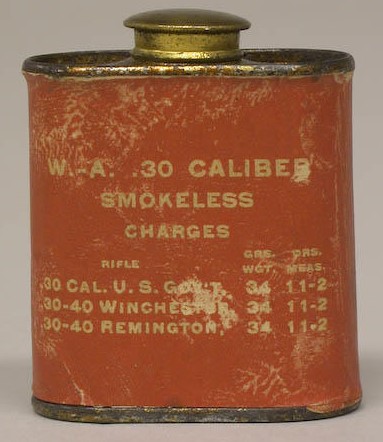
I just received a Cimarron model P 1873 in 45 Colt at my gunshop two days ago. The cost was $575 shipping and sales tax it was around $625 out the door.
When do we get photos?
![]()
I have to go meet a guy at the gunshop this morning. He wants to test one if my suppressors on his 300 Win Mag. I can take pictures of it then.
Well don’t stop there, add suppressor pics too!
We have an empty Class III category ![]()
Heck, add the suppressor to the 1873 while you’re at it ![]()
Less than a week ago I actually had a customer ask me if i would thread his revolver for a suppressor!
Welcome @samlcolt1873 Samcolt1873 to the forum. Enjoy.
–Al
